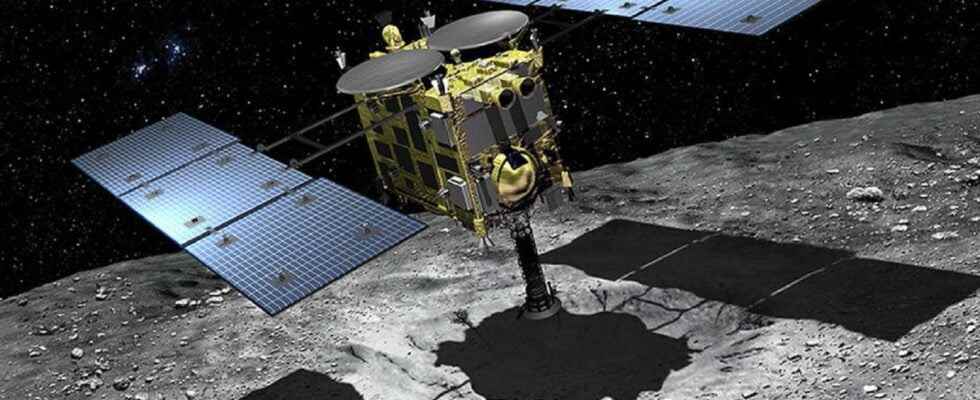Just over a year ago, the Hayabusa-2 probe brought back samples from the asteroid Ryugu. The first analyzes of this material reveal unexpected information, questioning our knowledge of the history of the Solar System.
You will also be interested
[EN VIDÉO] The asteroid Itokawa in pictures This animation allows you to admire Itokawa, the first asteroid of which a sample, taken by the Japanese probe Hayabusa, returned to Earth. Analyzes have shown that this rather small NEO is in fact the result of the union of two distinct bodies.
The Hayabusa-2 probe, in orbit around (162173) Ryugu from June 2018 to November 2019, reported to us on December 5, 2020 samples of this asteroid. This week the of them first articles aboutanalysis of this material were published in Nature Astronomy.
Ryugu is a type C asteroid which is rocky and dark body rich in carbon and water. The chondrites carbonaceous, meteorites which would come such asteroids exhibit many characteristics indicating that they have been altered by fluids. These bodies, which would have been trained at the edge of the asteroid belt, contained ice mixed with rock. Part of the ice melted, which produced minerals clay and carbonates (salts).
One of the objectives of the mission Hayabusa-2 was to study the link between C-type asteroids and chondrites carbonaceous. This is important because carbonaceous chondrites are probably the kind of objects that have brought water and organic compounds on Earth, allowing the life to emerge there.
Dust less dense than expected
Hayabusa-2 collected 5.4 grams of dust, the equivalent of a teaspoon. It may not seem like much, but it is still several thousand grains that can be analyzed individually. As a reminder, the initial objective was to take 0.1 gram. As these samples are irreplaceable, analyzes began with non-invasive and non-destructive observations and are now followed by complex measurements that require handling and preparation of the specimens.
The Volumic mass apparent Ryugu had been measured by Hayabusa-2 at approximately 1.190 kg / m3. This low value was expected since the asteroid is assumed to be a pile of debris gathered following the collision of a larger body and therefore have a porosity high. On the other hand, what was the surprise when the density of the material collected turned out to be almost as low, around 1,300 kg / m3 ! The collection process should have compacted the grains, as well as the shaking during transit and entry into theatmosphere. This density is also much lower than that of presumed meteorites similar to Ryugu.
The authors put forward two additional reasons for this. Meteorites that ended up on Earth were previously ejected by collision from their parent asteroid. Unlike Ryugu’s material, which was protected by its capsule, their dive into the earth’s atmosphere caused their fragmentation. Thus, meteorites arriving on Earth have experienced at least one additional event that could decrease their porosity. Ryugu might also contain more low density material, like organic molecules, that such meteorites. This is important because it implies that the Ryugu material has retained some matter carbonaceous that we have not been able to study before. This should allow us to learn more about the essential building blocks of life.
Preliminary grain analysis
The composition of many Ryugu grains was also evaluated by spectroscopy. This is not the most common technique for preliminary compositional analysis, but it has been used because it is non-destructive, requires no sample preparation, and allows direct comparison of grains with measurements taken at the surface of the body. Ryugu by Hayabusa-2.
Not surprisingly, the grains and the surface of the asteroid have some spectra very similar, both with the same water footprint (as hydroxide, OH). More detailed laboratory analysis, at wavelengths higher than those measured on the asteroid, revealed additional characteristics, including one identified as coming from a nitrogen component which, according to the authors, could come from clay minerals containing ammonium or from an organic material rich in nitrogen. However, a different analytical technique will be required to determine the abundance of organic compounds in the samples.
The authors also found a huge grain of carbonate about half a millimeter long that could be rich in iron, very characteristic of this type of meteorite.
While this is a preliminary analysis, these papers show that Ryugu’s material is primitive and different enough from known meteorites to raise questions about the extent to which meteorites are representative of asteroids. This could change some aspect of our view ofsolar system history.
What you must remember
- Ryugu’s samples are less dense than expected. This would indicate that Ryugu contains carbonaceous matter.
- The grains also contain water and a nitrogen component.
- Ryugu’s material is primitive and different from known meteorites, questioning the extent to which meteorites are representative of asteroids.
Interested in what you just read?
.
fs3
